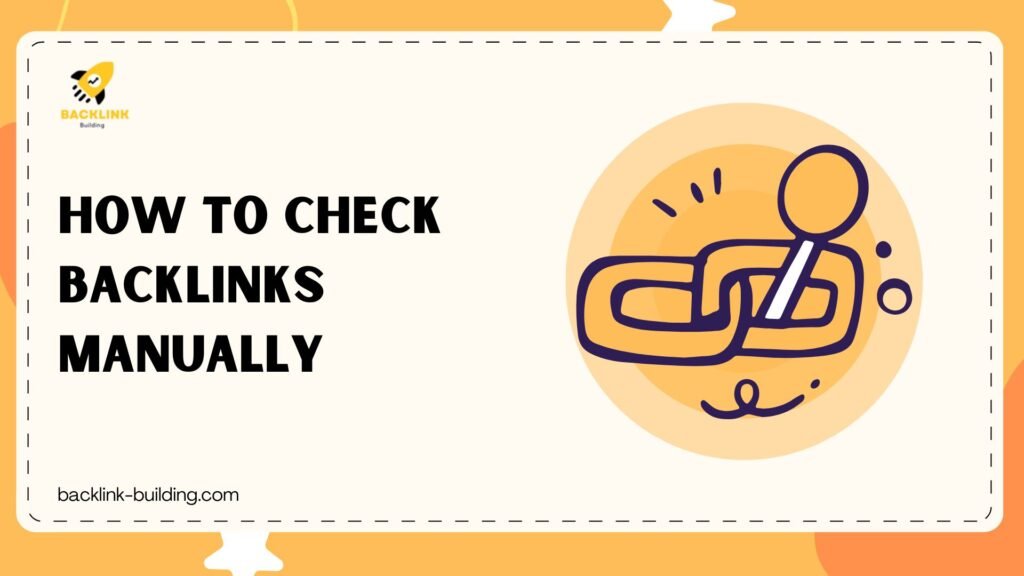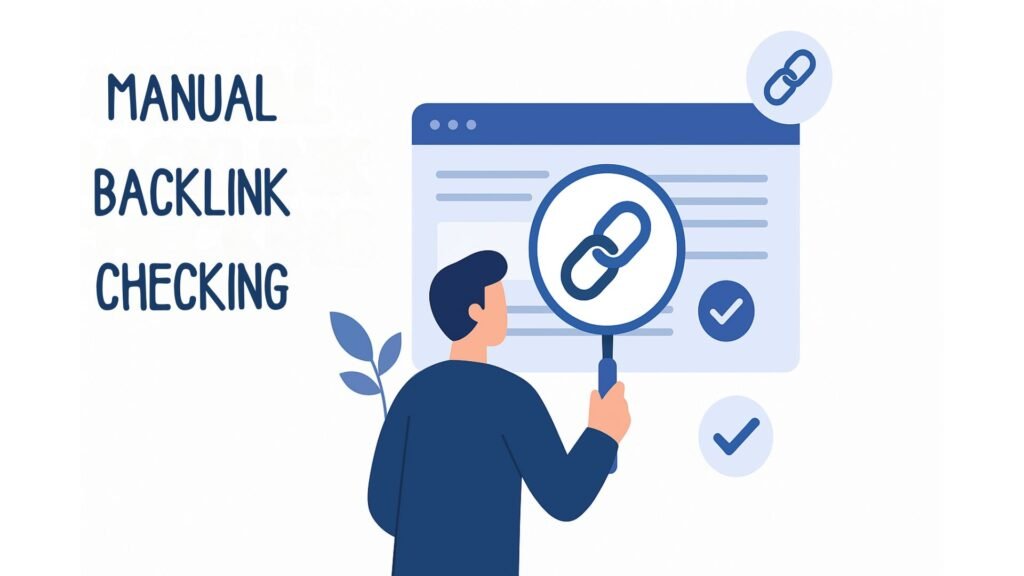
Backlinks are one of the most important things for any website. If you want to get better rankings on Google and bring more visitors to your site, you need to know who is linking to you. But what if you want to check backlinks without using any fancy tools or paid software?
That is where manual backlink checking comes in.
In this guide, we will walk you through how to check backlinks manually, step by step. No complicated terms. No paid tools. Just simple ways to find out who is linking to your website.
What is Manual Backlink Checking

A manual backlink checking is the process of reviewing the backlinks pointing to your website by inspecting them individually, rather than relying on automated tools or reports. This hands-on approach allows you to assess the quality, relevance, and health of each backlink, ensuring they align with your SEO goals.
Why You Should Check Backlinks Manually
You might ask – why do I need to check backlinks myself?
Here are a few good reasons:
- Quality Control: Ensure links come from reputable, relevant sites.
- Identify Toxic Links: Spot harmful backlinks that could harm SEO.
- Relevance: Confirm backlinks are from relevant, authoritative sources.
- Monitor Anchor Text: Ensure natural and varied anchor text.
- Spot Broken Links: Find lost or broken links that need fixing.
- Avoid Penalties: Disavow links that violate Google’s guidelines.
- Improve Link Strategy: Learn from successful backlink sources for future campaigns.
Manual checks provide deeper insights into the health of your backlink profile.
When Should You Check Backlinks Manually?
You should check backlinks manually in the following cases:
- After a Google Algorithm Update: To ensure your links are still valuable.
- When Rankings Drop: To identify harmful backlinks.
- Before and After Link-Building Campaigns: To verify link quality and placement.
- After Website Changes: To check for broken or outdated links.
- Suspected Negative SEO Attack: To spot and disavow malicious links.
- Receiving a Google Penalty: To identify the backlinks that caused the penalty.
- During Regular SEO Audits: To maintain a healthy backlink profile.
What You Need To Get Started
You do not need much. Just a few basic things:
- A laptop or phone with internet
- Your website URL
- A bit of time and patience
- Google search (yes, that is it)
Ready? Let us begin.
How to Check Backlinks Manually
Finding backlinks manually requires a more hands-on approach compared to relying on automated tools, but it gives you greater control and understanding of your website’s backlink profile. Here’s a step-by-step guide to help you find backlinks manually:
1. Search for Your Domain Name in Search Engines
The first step in finding backlinks is to search for your domain name or specific pages in search engines like Google or Bing. Use the following search operators to find backlinks:
- “site:yourdomain.com” – This will show pages from your website indexed by search engines, which may include backlinks.
- “link:yourdomain.com” – Google used to offer this operator to see links pointing to your site, but it has been deprecated. However, some other search engines or SEO tools may still support it.
- Your domain name in quotes – Searching for “yourdomain.com” can return pages where your website is mentioned or linked.
Example:
site:yourdomain.com
“yourdomain.com”
This will help you find pages that either link to your site directly or mention it, which can sometimes include backlinks.
2. Use Google Search Console (GSC)
If you have Google Search Console (GSC) set up for your website, it’s a valuable tool for finding backlinks. Here’s how you can use it:
- Log in to Google Search Console and select your website.
- Navigate to “Links” in the left-hand menu under the “Legacy tools and reports” section.
- In the “External Links” section, you’ll see a list of the top linking domains and top linked pages.
GSC gives you direct access to backlinks that Google has identified, though it may not show every backlink due to its sampling approach. It’s still a great starting point.
3. Manually Check Referring Pages
You can also check referring pages directly:
- Check backlink sources: Visit websites or blogs where you suspect your links might be placed. Often, content marketing, guest posts, interviews, or press releases will contain backlinks.
- Look for guest post opportunities: If you have written guest posts, visit the blog or website where your article was published to verify that your backlink is live.
- Check forums or comment sections: If you’ve contributed to forums or left comments with links, revisit these pages to ensure the link is still present.
4. Monitor Social Media Mentions
Backlinks can sometimes be found on social media platforms. Search for your brand or domain on sites like Twitter, LinkedIn, Facebook, Reddit, or niche-specific forums. Here’s how:
- Search for your brand or domain name: Use the search bar on social media sites to see if users have mentioned or linked to your website.
- Check for content shares: If your content has been shared, sometimes those shared posts include links pointing back to your site.
Tools like Twitter search or Reddit’s search function can help you find mentions of your site.
5. Look for Competitor Backlinks
Another way to find backlinks is by analyzing your competitors’ backlinks manually. This method can help you uncover new link opportunities. Here’s how you can do it:
- Identify your competitors in your industry or niche.
- Search for their backlinks using the same method as you would for your own site. For example, you can search Google for “site:competitordomain.com”, and look at their referring pages.
- Review their guest posts, partnerships, and content marketing efforts. This will help you see where they are getting backlinks from and may uncover opportunities for your own site.
6. Check Your Content for Natural Mentions
Sometimes, people link to your content without you directly knowing. Search for mentions of your content, brand name, or specific pages that may not be obvious backlinks. You can search by your article or product name, and if someone has linked to it without notifying you, you’ll find it this way.
7. Look Through Directories and Local Listings
If your website is listed in business directories or local citation sites, these can also act as backlinks. Check directories relevant to your business, local listings, and professional associations. These can be checked manually by visiting the directory websites and searching for your listing.
8. Check Email Outreach Results
If you’ve done outreach or participated in link-building campaigns, you should check your emails for links from partners, guest post offers, or bloggers who agreed to link back to your site. Manually check each link to ensure they’ve been published.
9. Monitor Press Mentions
If you’ve been featured in the press or have worked with journalists, there may be backlinks in articles about your brand. Look for mentions of your website in news outlets, blogs, or industry publications. Often, these will include a backlink to your homepage or relevant content.
Things To Check When You Find a Backlink
Now that you know where to look, what should you check when you find a backlink?
Here is a checklist:
- Is the link live?
Make sure the link actually works and is not broken. - Is it clickable?
The link should be a proper hyperlink, not just plain text. - Is it dofollow or nofollow?
Dofollow links pass SEO value. Nofollow links do not. You can check by right-clicking the link and viewing the page source. - Is the page relevant?
See if the page is about something similar to your site or topic. - Is it a good-quality site?
Avoid spammy or shady-looking websites. - What anchor text is used?
This is the text that people click on. It should be natural, not stuffed with keywords.
How Often Should You Check
There is no fixed rule. But here is a simple suggestion:
- Small websites – once a month
- Medium websites – every two weeks
- Larger websites – weekly
It also depends on how active you are with marketing and content. The more you promote, the more links you get, so you should check more often.
Create a Simple Backlink Tracker
To keep things organized, you can make a simple spreadsheet to track your backlinks.
Here is what you can include:
- Website name
- Page URL
- Date found
- Anchor text
- Type of link (dofollow or nofollow)
- Status (live or broken)
- Notes
This helps you manage your links and take action if needed.
What To Do After You Find Backlinks
Checking backlinks is just the first step. Here is what you can do next:
If the link is good:
- Say thank you to the person or site
- Share their content
- Keep building a connection
If the link is broken:
- Reach out and ask them to fix it
If the link is bad:
- Contact the site and request removal
- If they do not respond, you can disavow the link through Google Search Console
Final Thoughts
Checking backlinks manually might take a bit more time, but it gives you full control. You get to see exactly who is linking to your site and how.
You also learn a lot about your website and audience in the process.
Just follow the simple steps we talked about:
- Use Google search tricks
- Check referral traffic
- Explore social mentions
- Try reverse image search
- Look through forums and comment sections
- Keep track in a simple sheet
Keep doing this regularly and you will stay ahead of your SEO game without spending a single dollar.


